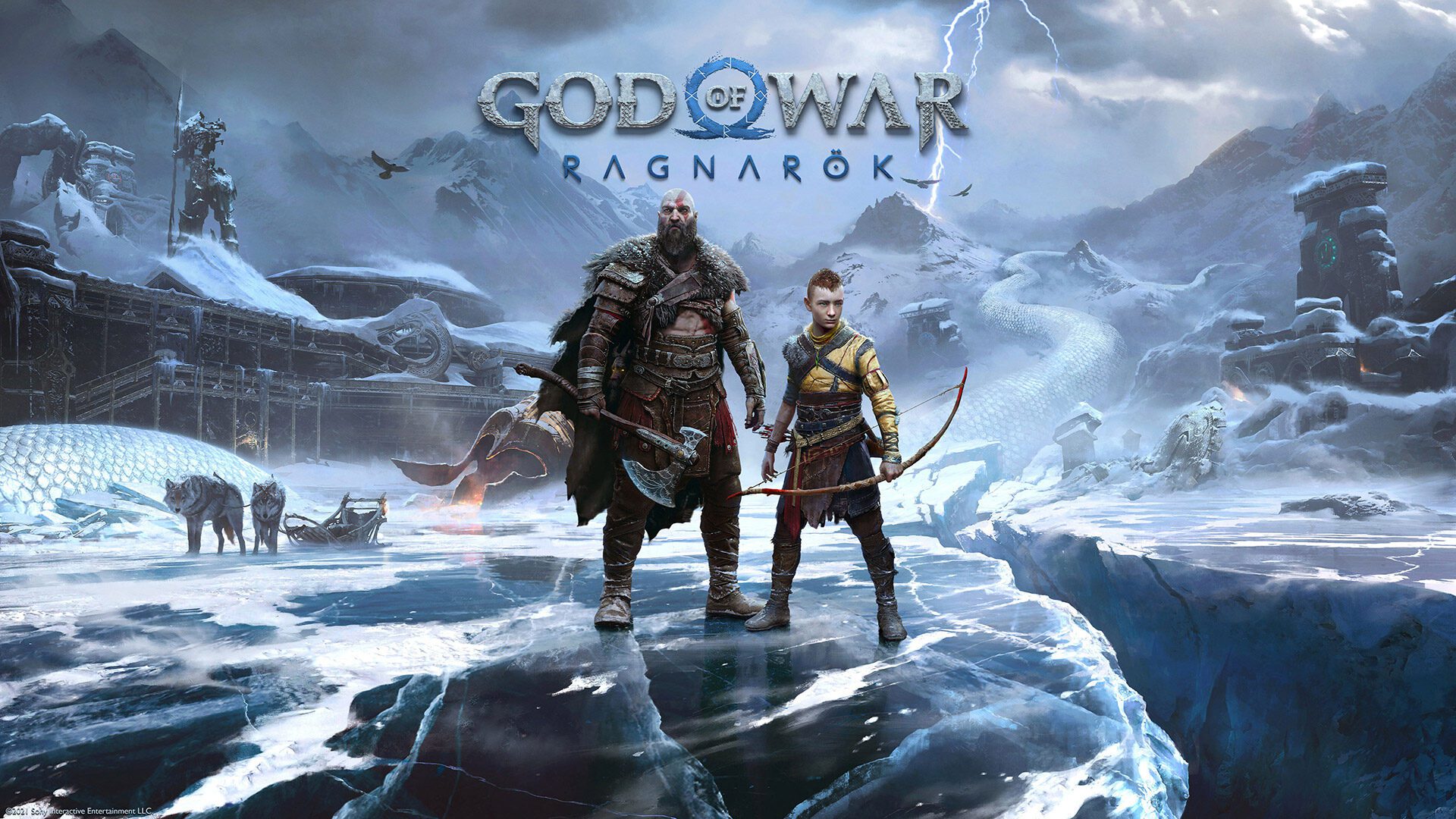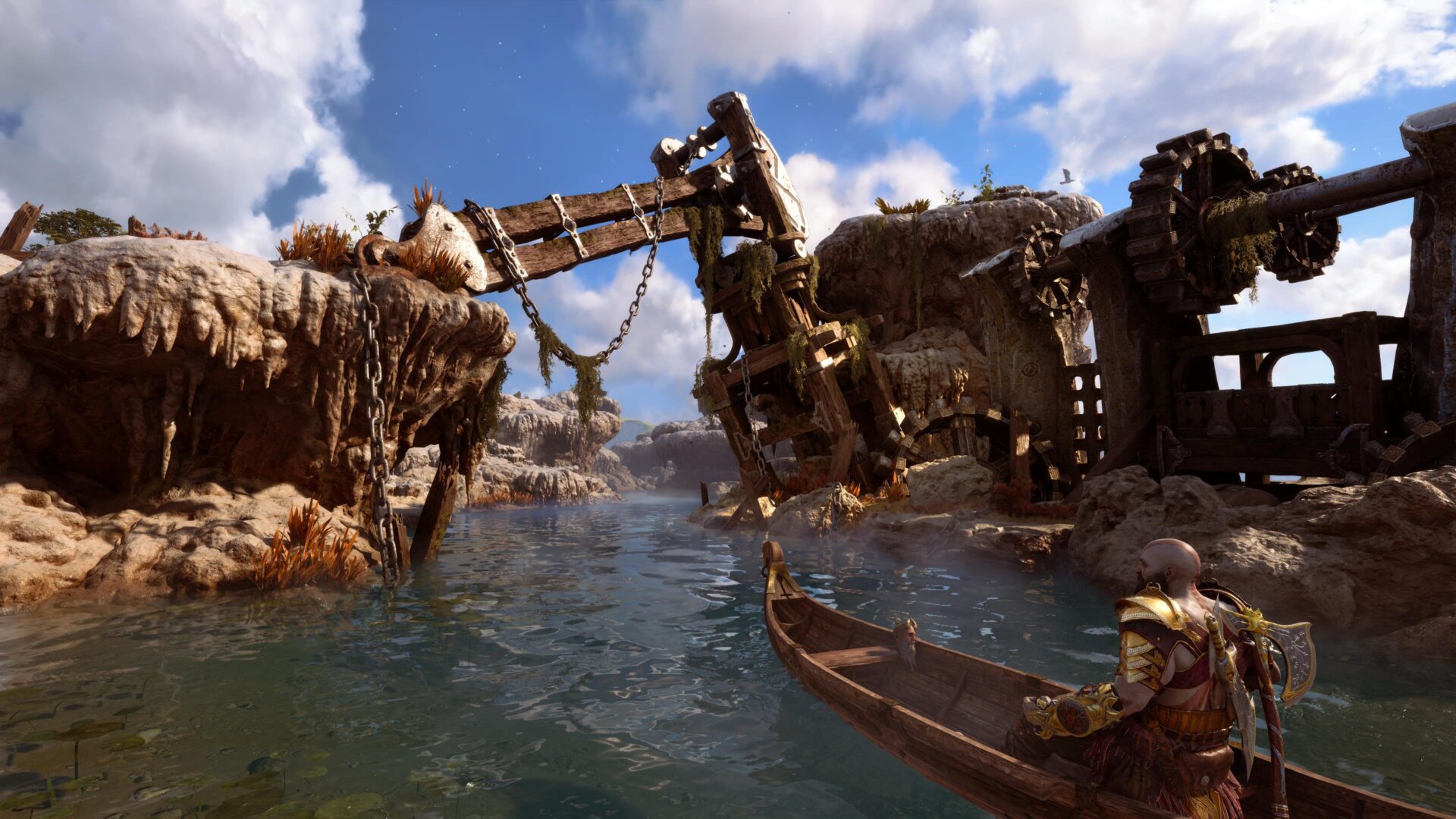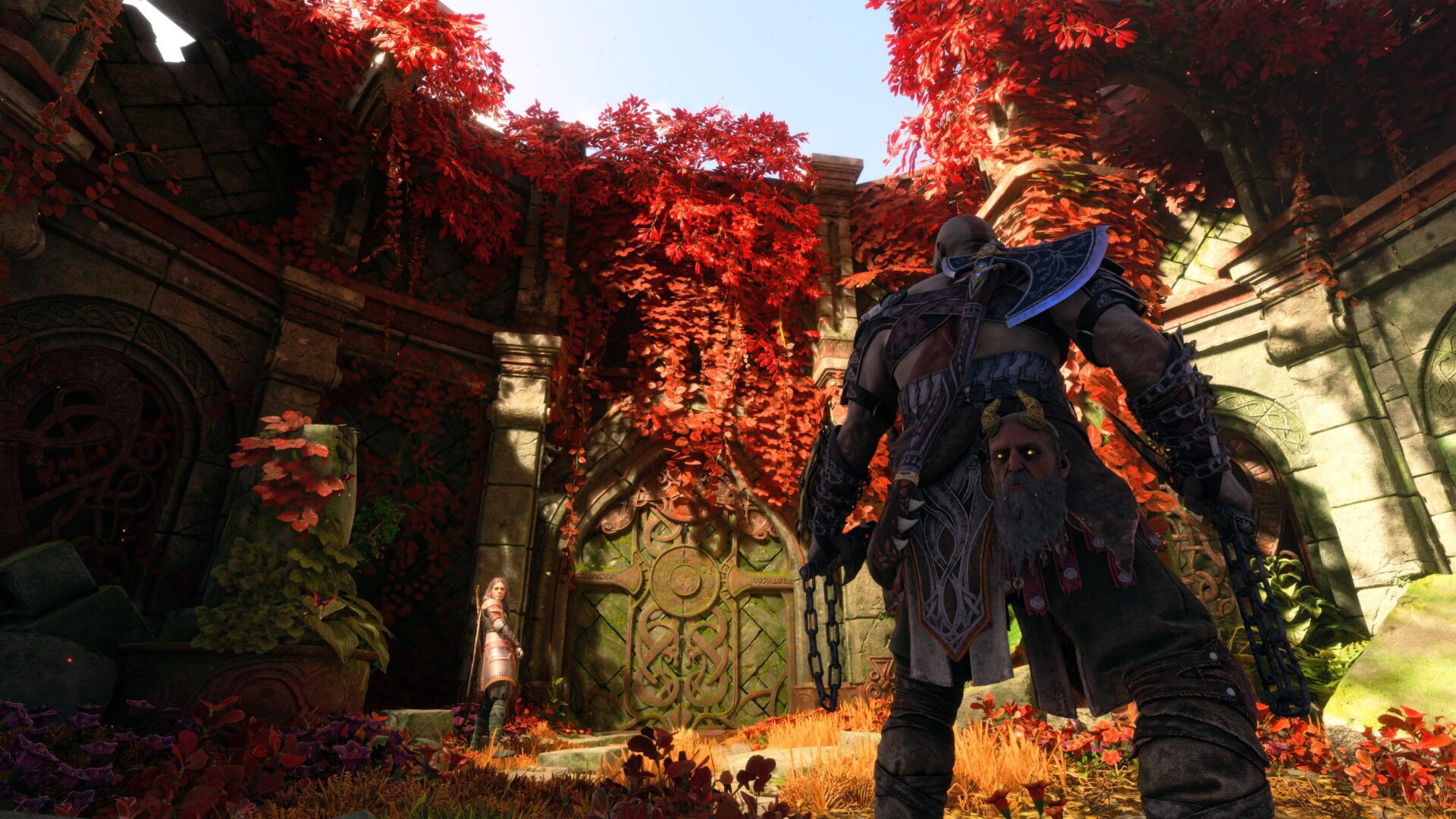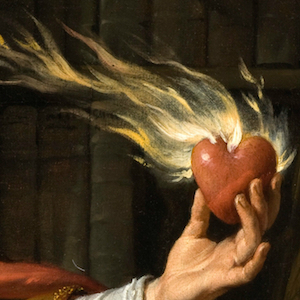
Games that receive a ⭐ have a score of 95% or above. This is purely from a game design perspective and is not in any way related to our morality/parental warnings section.
In 2018, Sony Santa Monica’s God of War brought an exciting mix of visceral combat, puzzle solving, and engrossing cinematography to a tale of a father, along with his son, pursuing his wife’s dying wish. Its loose ends and massive success all but demanded a follow-up, which was released in November of 2022. Does the sequel live up to the promise of the original, and is there any spiritual substance to chew on?
Short answers: yes and yes. This game has already received heaps of deserved praise, and there’s more below.
Ragnarok continues directly from its predecessor, and finds its characters burdened by the weight of prophecy like the snow-laden land of Midgard. Fimbulwinter has arrived; a brutally and uniquely cold winter that presages the coming of Ragnarok, the twilight of Asgard’s gods. In a bid to avoid that fate, Odin offers peace to Kratos in exchange for assistance from Kratos’s son, Atreus, whom Odin needs as an apprentice of sorts in service of his hidden ends. Kratos naturally mistrusts the Aesir king and rejects Odin’s terms.
Atreus, still intrigued by the offer, concocts a plan by which he believes he can learn from the apprenticeship without truly assisting Odin. What follows is better experienced than summarized here, but suffice to say it is a truly moving story with surprising substance and refreshing depth of characterization.
In many ways, God of War: Ragnarok avoids what have become commonplace tropes of modern pop-culture (perhaps because of the myths from which it draws inspiration). Yes, there are world-spanning and potentially world-shattering consequences in the offing, but the real stakes of the story are far more personal, keeping the adventure meaningful and relatable. Yes, the heroes have flaws, but rather than be excused, dismissed, or celebrated, they are acknowledged as something to grow beyond. And yes, there are conflicts between the heroes, but they develop organically from logical character behavior, or the choices between what are seen as competing goods rather than being thinly contrived for plot purposes.

It certainly doesn’t hurt that the game is gorgeous at every turn. There’s an imaginative quality to each world you visit owing to grandiose natural vistas, impressive architectural feats, the mythological beings who populate the worlds, or all of the above. Curmudgeons could maybe argue that the realms you visit reduce to standard fantasy gaming biomes, but they’re all woven into Ragnarok‘s adventure in a way that integrates the diverse domains into the context of Norse legend. Additionally, exploration of those worlds (both via story progression and side-quests) rewards players with memorable quests and/or set-pieces that make you feel like you’re part of a myth.
Just as in 2018’s God of War, Ragnarok‘s seamless design unfurls those myths effortlessly. Ragnarok continues God of War‘s convention of the single-take, over-the-shoulder camera, so you never lose momentum. Even when the story takes natural moments to breathe, there’s plenty of impetus to continue the main story, or incentives to explore. Interactions with and between your companions essentially take place at all times, providing natural exposition and character development, as well as hints for puzzle solving. That was true of God of War as well, but it seems like the developers took it a step further in the sequel.
Beyond the character banter en route between various points of interest, the game has an impressive awareness of your activities. If you’re starting to wander a little aimlessly, your companion might gently point you in the right direction. If you’re in the middle of a puzzle, your companions will prompt you differently depending on your actions, both affirming good choices that aren’t quite enough and foreclosing paths that simply won’t work.
That’s not to say it’s perfect; a few flaws here and there will remind you you’re playing a game. Your companions will occasionally repeat themselves, or be too quick to point out the obvious. Also, in the years since God of War, the characters have not learned that stories don’t need to stop just because they’re leaving a vehicle. Still, it’s a testament to the quality of the writing and worldbuilding that you might actually want to have a little bit farther to travel (or are simply willing to wait) to hear the end of a conversation. Those moments are a keen bit of design that serves the player while often simultaneously adding flavor to the characters.
More often than not, however, your companions’ guidance is not something you’ll need to rely on. Ragnarok rarely, if ever, throws you a headscratcher, and your options are communicated with clear and consistent visual cues. I imagine both of those are deliberate choices in favor of pacing, and in a game that’s more focused on the plot, characters, and combat, I think the designers made a fair call. Still, I can’t help but be reminded I’m playing a video game when, for example, everywhere I go in the nine realms, I find identical chain-driven pulley systems with the same freezable gears. Or perhaps more incredible, every path I can climb has been helpfully painted by what I can only assume are some enterprising, artistically-inclined fae Sony Santa Monica uncovered deep in the Eddas. God of War: Ragnarok is by no means the only, or even the worst offender with these visual cues. It’s just that in a game this committed to its world and characters, and in a game that’s ultimately just this good, these concessions to modern game design could probably have been solved differently. Nitpicks aside, the puzzles you encounter are still decently satisfying and don’t overstay their welcome. Much more of your time will be spent in combat, anyway.
The flow of the fighting will be familiar to players of 2018’s God of War, but that’s by no means a bad thing. For the uninitiated, you construct simple combos from light and heavy attacks using your ice-imbued Leviathan Axe or fiery Blades of Chaos. Each weapon has attack strings and ranged attack options that have value in different situations, and their individual elemental properties can exploit the weaknesses of certain foes as indicated on their health bars. You are also again given the choice among several Runic Attacks for each weapon, which are unique, cooldown-driven magic attacks you can tailor to your playstyle. It’s a system that feels as fluid and as satisfying as the original, and introduces some new concepts as the game progresses.
Character customization comes primarily through weapon-specific skill trees and your equipment choices. The skill selections are more meaningful in the early game, as doing a moderate amount of the side content will provide you with enough points to unlock each weapon skill by game’s end. The purpose of that system seems more as a means to keep the player from being overwhelmed by needing to learn too many moves at once. Equipment selection, on the other hand, is more impactful. Beyond passive stat bonuses, armor sets often will grant Kratos a unique perk designed to fit with a specific playstyle (e.g. a weapon skill might be modified to deflect projectiles, parries might additionally grant a stacking bonus to attack power, etc.) You will also have an upgradable amulet that can hold various collectable trinkets which provide yet further set bonuses if you really want to min-max, but I never felt like that additional level of customization was required to proceed.
Testing your mettle in combat, and settling into your preferred fighting style is again a treat, especially in the boss battles. However, as is the case with Ragnarok‘s narrative, they’re something I do not want to spoil. Ultimately, this is a very easy recommendation, with the following parental warnings:
Parental Warnings
- There is quite a bit of colorful language in the game, particularly from your blacksmith, Brok. I often found his inventive metaphors hilarious, but would not repeat them in earshot of my children.
- The game is free of suggestive character designs, though the backstories of various characters revealed through dialogue still discuss some adult situations.
- You play as a god of war, and fight like one. There are realistically rendered gruesome combat maneuvers involving the creative dismemberment of mythological beings. This, however, is usually (but not always) limited to the non-humanoid enemies, and does not rise to the level of sickening violence glorification you might find in a Mortal Kombat 11 fatality. It’s a natural consequence of Kratos’s power, and seems like a fair adaptation of the kind of violence you’d read in a myth or epic poem.
- Some story elements depend on notions of the relationship between the soul and the body that Catholics do not share.
Now again, if you don’t want anything spoiled, and are aware of the caveats above, God of War: Ragnarok is an easy recommendation, especially if you enjoyed the predecessor. If, on the other hand, you want a taste of the moral and spiritual value, I’ll do my best to hint at it without too much detail, but I can’t avoid the broad strokes of the story.

Moral / Spiritual Value
There’s much worth affirming in this story, both in terms of basic character and writing quality as well as moral substance. Too often, modern storytelling seems to fall into one of two camps: cotton-candy thrill rides that use quips and a new coat of paint to vainly mask that they’re all on the same track, or gloomy regurgitations of the secular catechism du jour. Granted, the time constraints of fatherhood prevent/save me from keeping up with everything pop culture has to offer these days, so it’s possible my generalizations are unfair. Still, Ragnarok boldly bucks both of these trends, and I think it’s easiest to frame how it does so by examining its three principal characters.
Atreus has grown since the last outing, and in addition to some new skills has grown into the natural teen sense of invincibility. The writers are to be commended for capturing this in an endearing way. Atreus knows how to push Kratos’s buttons, and often correctly identifies Kratos’s fatherhood foibles, but Ragnarok never rests on the easy kid-always-right trope. Atreus is very much fallible, which not only makes him more realistic, but also provides several avenues for growth. We can see Atreus learn from his mistakes, watch Kratos grow as a father in the ways he guides and corrects Atreus, and in so doing watch them develop a stronger bond.
Freya also returns in Ragnarok, and we learn more about the enormous wounds she carries stemming from suffering she endured for her people at the hands of Odin. Seeing her choose to set that aside for the sake of others, and in particular ultimately adopting a motherly role for someone who’s partly responsible for the death of her own son adds to the power of the story. There’s also a refreshing sense of complementarity to Kratos and Freya – they are clearly more powerful fighting together for a common purpose than either would have been alone.
Finally, Kratos is once again depicted as a father who has made that role central to his life. His approach is not always perfect, but the ways in which he falls short as a father are entirely relatable and are borne out of a genuine desire to prepare his son for a harsh world. It’s inspiring to see Kratos struggle with and to an extent grow beyond his own insecurities. Even more than in 2018’s God of War, he’s also shown to have a genuine care for his companions, often sharing experiences from his own tragic and violent past to guide them away from the same mistakes. Some of the most poignant moments involve Kratos, in his way, encouraging others to see themselves as something more than they assume. This is not unlike one of the missions of the Church; communicating the fundamental truth that God loves each of us, and only through understanding that love can we understand who we are.
Perhaps what I find most refreshing about Kratos, though, points to a common fear I think we all have at some time or another. It’s easy to convince ourselves that subordinating our will to God’s is going to limit our freedom or somehow make us less ourselves, when in truth that is exactly backwards. We are not competing with God, but rather live only through his continual gift of love. Therefore, we are most free and most ourselves when we are what He intends us to be. I cannot help but be reminded of that when I see a character like Kratos, for whom fatherhood is not an impediment to his mission, but rather fatherhood is his mission.
I could say more, but not without spoiling the story, and it’s possible I’ve said too much for some already. Suffice it to say, I thought this game was a triumph from top to bottom – in an aesthetic sense, a technical sense, and even was surprisingly positive and moving in a moral sense.
Scoring: 99%
Story: 5/5
As discussed above, Ragnarok has numerous memorable characters and a moving narrative that’s among the best modern games have to offer.
Gameplay: 5/5
The game systems refine what was already smooth and satisfying in the predecessor, balancing satisfying challenge and feeling like a mythical hero.
Aesthetics: 4.9/5
Ragnarok is a feast for the eyes, though I did have some nitpicks on the indiscriminate repetition of visual cues. The score is often stirring as well, though it’s integrated to such a degree that I don’t have a desire to listen to it outside of the context of the game.
